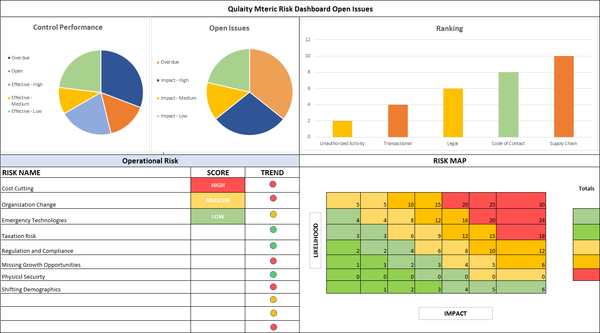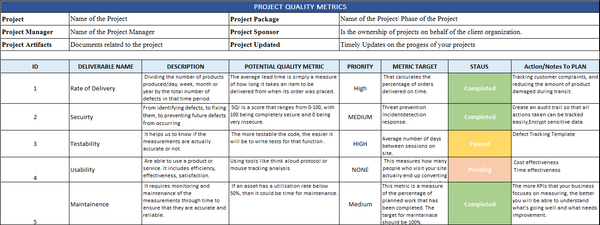Quality Metrics- What They Are and How To Use Them
Quality metrics are an essential part of the quality management system and provide a way to measure how well a process is performing. Quality managers can use these metrics to improve processes by identifying problems, analyzing root causes, and developing solutions. Quality metrics provide a standard for evaluating the quality of your product and processes. In addition, they can be used to measure the performance and reliability of products, services, or systems.

Quality metrics are a key component of any quality assurance program. They measure the performance of an organization's processes and products and provide information about what needs to be improved to achieve better results.
What Metrics Are Essential When Managing a Project?
Key Performance Indicators for Managing a Project include:
- Project Status - The first KPI is project status. It helps managers know where their projects stand, what they have accomplished, how much time has been spent on each task, and whether timelines were met.
- Budget Management - A second indicator is budget management. Organizations need to be careful with their money, so it's essential to keep tabs on spending levels for different departments and individual projects within those departments.
- Calculated vs. Actual Cost of the Project- The difference between what you projected to spend and how much was spent. This is a good indicator if your team members are overspending or underspending. It can also let you know when there has been scope creep on items that were not in the budget, resulting in an unexpectedly high cost for the project.
- Resource Utilization - With resource utilization, organizations want to make sure that they're not over-utilizing their resources.
- Risk Assessment- Organization uses these metrics as indicators for detecting potential problems and correcting them before they escalate into significant issues. The risk assessment involved in quality metrics is critical because it helps managers plan for future risks associated with each metric that is being monitored.
Which Project Metrics Help You See the Future?
Productivity metrics are a way to measure the efficiency of an organization. The process involves breaking up tasks into smaller, more manageable pieces and tracking how long each task takes to complete.
Some milestones must be completed.
- Goal setting: time-bound goals with specific targets.
- Priority Setting: taking inventory of what needs to get done vs. not getting done at all.
- Communication Planning/Routing Strategy: ensuring everyone is aware of deadlines and responsible for completing specific tasks to avoid overlapping or missing due dates.

Quality Project Metrics :
1.Customer Satisfaction: A company needs to measure customer satisfaction as it directly impacts quality metrics. Customer satisfaction can be measured in various ways, and an organization should have different strategies to achieve this. For example, one strategy could provide customers with quick service, while another might involve providing high-quality products or services.
2.The Net Promoter Score, or NPS: is a quality metric that measures the likelihood of customer referrals. The NPS is calculated by subtracting the percentage of customers who are not likely to refer your company from the percentage of customers who are likely to refer your company. A high score indicates that most customers would be happy with their experience and recommend it to others.
3.The number of errors and customer complaints: This metric counts all the mistakes made by employees within an organization and then divides them by the total number of employees. The result is expressed as a percentage with higher percentages indicating more mistakes per employee than lower portions.
4.On-time completion and planned hours vs. actual time spent: On-time completion is a metric that measures the percentage of jobs completed on time. Planned hours vs. exact time spent is also a metric, and it measures the difference between how long you expected to take for a job and how long you took. Evolved in quality metrics are qualities such as meeting customer expectations, safety, efficiency, or productivity.
5.The number of time and budget changes- Quality metrics are commonly used to measure a product or service quality. However, quality is evaluated using many different measurements, including budget and time changes.
6.Resource Conflict- The resource conflicts involved in quality metrics are a common problem. This often leads to a reduction in productivity and efficiency.

7 Types of Quality Metrics:
Quality metrics are the measurements of a product or service that determine its level of quality. Understanding what they are and how to use them is vital for a successful business, so we have outlined seven types.
1. Performance- Performance metrics are a significant component of quality metrics. Performance is about the performance of the process and not just how quickly it is completed. Here's what you need to know about performance metrics:
- They are often measured in terms of speed, accuracy, or quality.
- They can be used to measure processes as well as products.
- Different types of performance measures will be used depending on the process being evaluated.
2. Features- They help you identify areas where you can improve and show the positive effects of your changes.
3. Reliability- Reliability is a vital part of quality metrics. Quality can be defined as the degree to which an item satisfies stated and implied needs. Reliability, on the other hand, is a measurement that indicates how well a product performs its function in the time between when it was designed and when it will likely need servicing or replacement.
4. Conformance- To ensure that the quality of your product or service is top-notch, you need to be able to measure how well it conforms with what was expected. You can do this by having a plan for measuring and meeting expectations, continuously improving processes necessary for meeting those expectations, and constantly monitoring the process.
5. Durability- The durability of quality metrics is an important consideration. Quality metrics are used to monitor product quality and determine when it's time for a product recall. The durability of these measures can be affected by many factors, including external environmental conditions such as temperature or humidity.
6. Capturing Metrics- The quality of a product is one of the most critical aspects of its success. Quality metrics measure how well a company meets customer requirements and expectations and safety standards. They can be measured to provide information that will help companies make decisions about their products or services.
7. Aesthetics- It is essential to know what aesthetic qualities make up the best quality and their role in overall usability.
Metrics Measurement and Data Collection
Quality measurement is an essential part of quality management. It provides a means for organizations to measure the effectiveness and efficiency of their processes to continuous improvement efforts. Quality metrics can be categorized into five types:
- Process-based metrics are used to monitor process performance.
- Product-based metrics that customers or other stakeholders use to assess product quality.
- Outcome-based metrics provide information about a product's impact on customer needs and wants (e.g., satisfaction, perceived value).
- Customer feedback or voice-of-the-customer data collected from a variety of sources, including surveys, interviews, focus groups, etc.;
- Data analytics.



